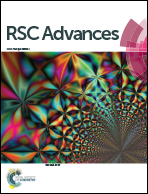Synthesis of micro/mesoporous silica material by dual-template method as a heterogeneous catalyst support for alkylation
Abstract
A series of micro/mesoporous composites were synthesized using non-ionic block copolymer Pluronic P123 and protic ionic liquid (triethylamine acetate) as the co-templates. The structures of all the composites were characterized by using small angle X-ray scattering, N2 gas sorption, dynamic laser light scattering (DLS), scanning electron microscopy (SEM) and transmission electron microscopy (TEM). The results reflected that the structure of the final silica materials changes along with the content of protic ionic liquid (PIL) and hydrothermal temperature. It was found that the sample whose mass ratio of PIL to (P123 + PIL) was 40% had a t-plot micropore area of 404 m2 g−1 at the hydrothermal temperature of 373 K, without destroying the ordered mesoporous structure. The formation mechanism of the micro/mesoporous silica which is based on the interaction between PIL and P123 is tentatively elucidated. 12-Tungstophosphoric acid (HPW) catalysts supported on these micro/mesoporous materials were prepared by impregnation, and their catalytic performances were investigated in the alkylation of o-xylene with styrene. Alkylation results showed that all the catalysts showed high catalytic performance in terms of propane conversion and selectivity to propene.


 Please wait while we load your content...
Please wait while we load your content...